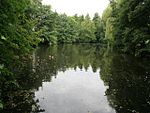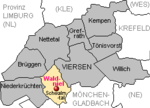Kent School, Hostert
1963 establishments in Germany1992 disestablishments in GermanyBritish international schools in GermanyEducational institutions disestablished in 1992Educational institutions established in 1963 ... and 2 more
Schools in North Rhine-WestphaliaService Children's Education

Kent School was a British secondary school in Germany, with boarding facilities, for the children of military personnel. It was located near the military complex at JHQ Rheindahlen, at Hostert, near Mönchengladbach. The school operated from 1963 until 1986 when it was amalgamated with Queens School, Rheindahlen, to become Windsor School. It was one of several secondary schools in Germany operated by the Service Children's Education organization.
Excerpt from the Wikipedia article Kent School, Hostert (License: CC BY-SA 3.0, Authors, Images).Kent School, Hostert
Eschenrath,
Geographical coordinates (GPS) Address Nearby Places Show on map
Geographical coordinates (GPS)
| Latitude | Longitude |
|---|---|
| N 51.209675 ° | E 6.3043666666667 ° |
Address
Eschenrath 7
41366
North Rhine-Westphalia, Germany
Open on Google Maps




